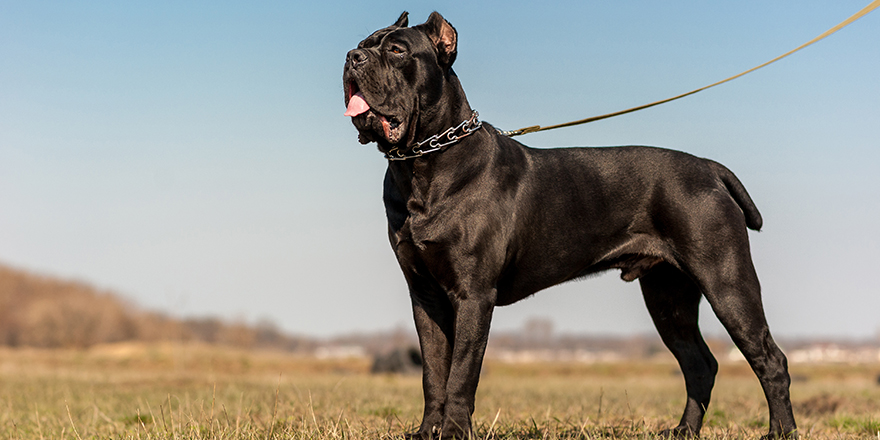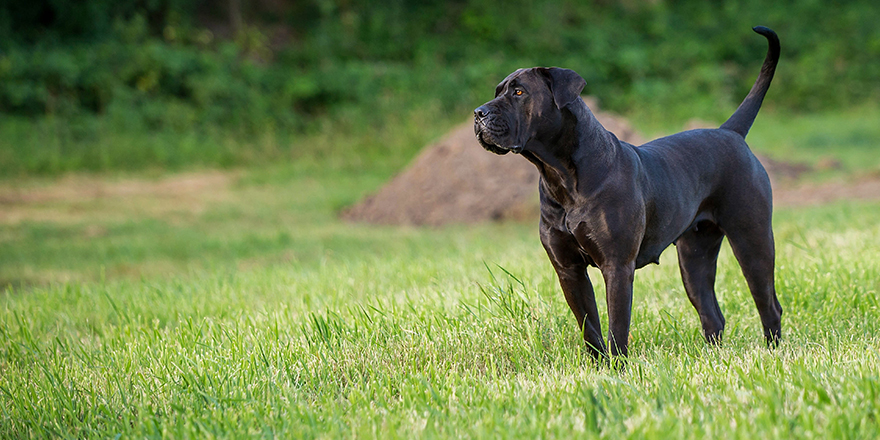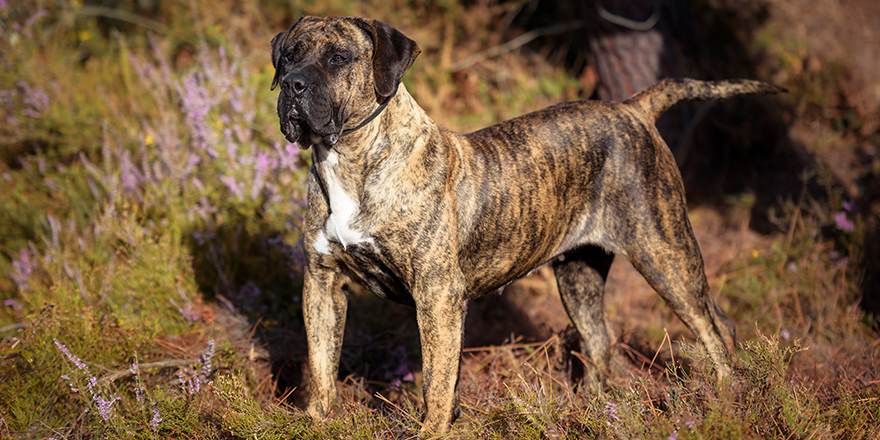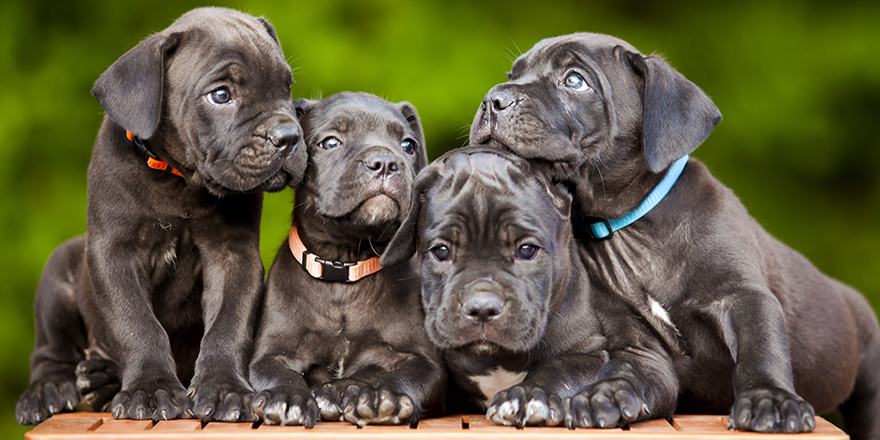Though both the Cane Corso and the Presa Canario have similar features and body types, these two breeds are very different. Both dogs are big, which, like all large dog breeds, gives them a bad reputation. But as all dog lovers know, a breed’s history does not mean that every dog from the breed will be the same. The way that humans used these breeds in the past does not denote the way your new Presa Canario or Cane Corso will act when they come into your family.
In this guide, we look at the differences and the similarities of both the Presa Canario and the Cane Corso. We’ll also explore the history of both breeds and explain why they are often mistaken for each other.
Cane Corso vs Presa Canario: Introducing the Breeds
The Presa Canario and Cane Corso breed are both a part of the Mastiff breed family. These Mediterranean Mastiffs are of such a similar shape and size that they could pass as the same dog.
Even though they were born in different parts of Europe, their history mirrored each others.
Cane Corso

History
The ancestors of the modern Cane Corso can be traced back to the time of the Roman Empire. This breed belongs to a subcategory of working breeds known as Mollosers. The first Cane Corso dogs were used as battle dogs; they would charge the enemy’s lines with buckets of flaming oil strapped to their backs. These early Corso dogs were larger than today’s variation.
After the Western Empire was dissolved in the 5th century, Cane Corso dogs were adopted to day-to-day jobs, often used to herd livestock, farm, and hunt wild boar. They were also incredible guard dogs, usually employed to guard farmsteads and henhouses around the Italian countryside.
By the middle of the 20th century, because of the constant invasions and economic upheavals of Italy and Sicily, the breed almost went extinct. It wasn’t until the 1970s that a group of lovers of the breed brought themselves together to try and revive the Cane Corso. The Society of Cane Corso Lovers was formed in 1983, and the first Corso was imported to America in 1988.
The Cane Corso was recognized as a breed by the American Kennel Club in 2010. They are part of the working dog group.
Appearance
A little taller than the Presa Canario, but not as heavy, the Cane Corso has seven different official coat colors. Of these, the only one that the breed shares with the Presa Canario is a fawn tone.
Cane Corsos have denser fur, which can feel a little rough to the touch. Some owners choose to keep their ears cropped – but this is an unnecessary procedure with no real benefit and is just a stylistic choice on the owner’s part. The natural state of this pup’s ears is a cute floppy pair of ears.
Personality
The Cane Corso puppy will show more signs of sociability than Presa Canario. These amazing dogs are one of the many large breeds that are great around families with young children and other pets – unfortunately, the Presa Canario has a higher prey drive, which can be an issue if you own small pets.
The Cane Corso’s name derives from a Latin word that means “guardian”. These Mastiff-type dogs are perhaps the best dog of their breed group to live with other dogs in a family home. Early socialization is recommended, especially if you’re looking to have two dogs or more in the future.
Cane Corso dogs are also very smart, loyal, and make great companions. Even powerful dogs can be unendingly kind and patient around small children if given the proper training.
Presa Canario

History
Presa Canarios started their life in the Canary Islands, with documentation of the breed going back to the 15th century. Their full breed name is “Perro de Presa Canario”, which translates into “Canary Dog of Prey”.
It is thought that the Iberian Presa provided the foundation for the Presa Canario and it’s likely that several other Hispanic dog breeds contributed their genetics to the mix over time (such as the Presa Espanol and the Alano). Another breed that was certainly involved in the creation of the Perro de Presa Canario was the Bardino Majorero, a sheepdog from the island of Fuerteventura.
Presa Canario were often used as guard dogs for farms that needed help herding cattle. They would also be employed to kill any local wild dogs that threatened the cattle they looked after.
When dog fighting became more popular, Presa Canario dogs became part of the cruel sport. It was their continued use in dogfighting that almost led to their extinction in the 1940s. This alongside their replacement as a farm guard dogs, meant that the breed became very scarce. If it wasn’t for fans of the breed coming together in the 70s to recover the breed’s numbers, they may have been lost to history.
These later Presa Canarios were large, strong, and vigorous dogs. They were calm, confident, courageous, and very territorial. The full recovery of the breed started in the early 80s when an association was formed with the goal of bringing the breed back to full health.
Some Kennel Clubs do not recognize the Perro de Presa Canario, but the American Kennel Club does in a way. They have the breed registered under the Foundation Stock Service group; a group of purebred dog breeds that are used to continue the development of a breed. These breeds are not eligible for registration with the AKC, but they can compete in AKC Companion Events.
Appearance
The Presa Canario is shorter than the Cane Corso, by an average of one inch, which makes it incredibly difficult to tell the breeds apart based on their height. They are the heavier of the two breeds, though, and have a stocky appearance.
Presa Canarios have six official coat colors, and all but one (fawn) is different from the coat colors offered by the Cane Corso.
These guard dogs have a black masks. The markings will not go above their eyes, but their nose, lips, and the rims of their eyes are always black. Their ears are large and droop down to sit by their cheeks.
Personality
A Presa Canario puppy from a reputable breeder can become a great family dog. These dogs are medium-energy dogs, which makes them extremely suitable for all kinds of living situations. They are an intelligent breed and enjoy spending time with their owners.
With their past as guards and hunting dogs, today’s Presa Canarios are very protective working dogs. They’re still employed on farms, but you’re just as likely to see one of these large dogs being walked by a family. Big dogs can be off-putting to new owners, but the Presa Canario is an excellent canine companion for the experienced dog owner.
Breed Similarities

- Their height. The Cane Corso grows between 23 and 27 inches, while the Presa Canario grows between 22 and 26 inches.
- Their weight. Cane Corsos weigh an average of 88 to 110 pounds, and Presa Canarios weigh an average of 80 to 130 pounds.
- Their lifespan. Both dogs live essentially the same number of years, averaging a minimum of 9 years and a maximum of 11 to 12 years.
- Both dog breeds have an average energy level.
- Both breeds cost around the same amount (you can expect to pay upwards of $1,500 USD for Cane Corsos or Presa Canario dogs.
- Both breeds share the potential for a fawn coat color.
- Both breeds almost went extinct and revival for the two dogs started during the 70s.
Elbow Dysplasia
A joint condition in dogs that causes pain, swelling, and potentially arthritis in their elbows. The condition can be managed with diet and exercise, but it is a lifelong condition for a number of dog breeds. It’s not as common as Hip Dysplasia, but it’s still a painful condition for dogs to live with.
Pups with Elbow Dysplasia may experience a limb in one or both of their front legs, and it can cause lameness in dogs with the condition. Dog owners may notice Elbow Dysplasia in their pups from a young age, but it can affect them at any time in their life.
Hip Dysplasia
In a similar vein to Elbow Dysplasia, Hip Dysplasia is a condition that affects the back legs of a canine. Again, this can cause lameness in the limbs if your pup has a severe case, but it mostly just causes pain, swelling, and soreness.
Both conditions can benefit from joint supplements being added to your dog’s daily diet. Dog joint supplements often contain Glucosamine, Chondroitin, and MSM, all of which can help joints become more supple and reduce swelling and pain.
Gastric Torsion
Also known as Bloat or simply Stomach Twisting, Gastric Torsion is a life-threatening disorder that occurs when a dog’s stomach fills up with gas and twists itself. It typically happens in breeds that are deep-chested, such as Mastiff-type dog breeds. If your dog develops breathing problems, an enlarged stomach is overproducing saliva, is agitated, and is trying to vomit, get them to a vet. These five signs are the symptoms of Gastric Torsion.
Obesity
Canines are considered to be overweight when they are between 10 and 20 percent above their ideal body weight. It’s a small percentage for a human, but for dogs, even being a few pounds overweight can affect their health.
To help your dog lose weight, you’ll need to change their diet and up their exercise without creating issues with other health problems they have. For example, you don’t want to overwork a pup with Elbow or Hip Dysplasia to the point where they’re limping around. You need to find the right balance for your dog.
Other Health Issues
In addition to the above health conditions, a Presa Canario may also develop:
- Entropion Cryptorchidism
- Epilepsy
- Food allergies
- Hypothyroidism
- Osteochondritis Dissecans
- Seasonal allergies
While a Cane Corso may develop these conditions:
- Bloat
- Cruciate Ligament Rupture
- Demodectic Mange
- Wobbler’s Syndrome
Difference Between Presa Canario and Cane Corso Dogs

Despite their similar histories, almost-extinctions, and notably similar appearances, there are some existing differences between these two Mastiff-type dog breeds. They aren’t the same breed, having come into the world in different places and at different times, although they share similarities in their history.
While looking at the Canario vs Cane discussion, you may have noted that the Canario is shorter but stockier, while the Cane is a little taller and slimmer. Depending on the examples of the breeds that you are trying to identify, this is a good place to start. Alternatively, as long as the dog you’re identifying isn’t fawn in color, you can identify both the Presa Canario and the Cane Corso by their fur color.
Presa Canario coat colors include:
- Brown
- Fawn
- Gold
- Orange
- Silver
- Tiger
They may also have white markings on their chest, base of neck/throat, forefeet, and the toes of their hind feet. A black mask should always be present.
Cane Corso coat colors include:
- Black
- Fawn
- Gray
- Gray Brindle
- Red
- Black Brindle
- Chestnut Brindle
Identifying by color is certainly the easiest way to tell apart a Perro de Presa Canario and a Cane Corso.
Further differences lie in their personalities. The Cane Corso is more suited to families because the Presa Canario has a higher prey drive and may try to chase or hunt any small animals you have. Canarios also aren’t as good with children.
Frequently Asked Questions
Both dogs are so similar in appearance, traits, and personality that choosing one over the other will lie in the smaller details. If you don't have small children or other pets, a Presa Canario will be the better choice, otherwise, you would be wise to adopt a Cane Corso to add to your current family. Both are working farm dog types, and make great guard dogs for the home. They are also loyal breeds, and will be happy to play tug of war regularly.
Mastiff-type dogs like the Presa Canario and Cane Corso can make excellent companions but they are large breed dogs, which can be difficult for new owners to handle if they don't have any experience. Our advise is to always meet the dog or puppy first to get a feel for their personality, and then do as much research as possible on the breed. If you can, see if anyone in your local area owns a Mastiff-type and is willing to let you meet them. Always adopt or buy a dog with as much information behind you as possible; lack of information one of the main ways that dogs end up in shelters.







